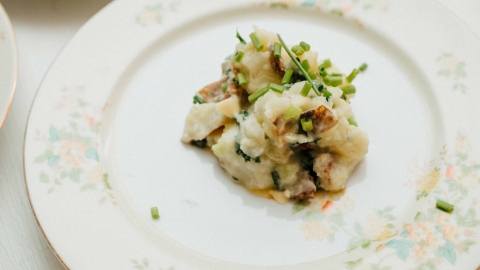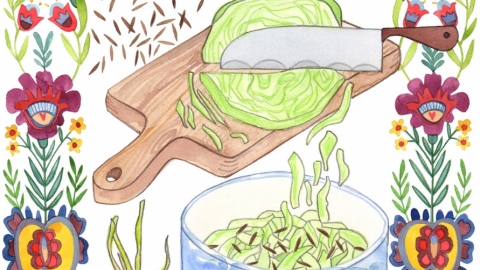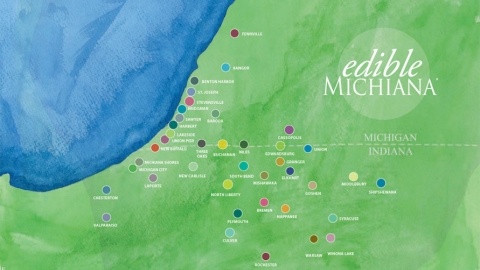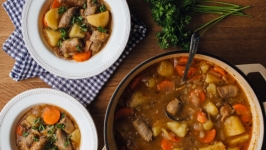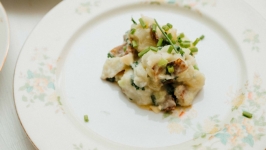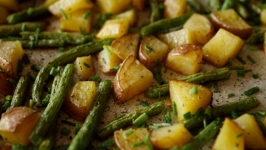Spuds and speed: notes on Irish cuisine, if there is such a thing
So important is the potato in the lives of the Irish that never once since my family’s blue Opel Kadett was returned to us after it had been stolen and left in a lane near Dublin City’s most notoriously dangerous street—“dog rough,” Dubliners used to call Sherriff Street—with a four-stone (56-pound!) bag of Golden Wonders missing from the boot, never once have I considered that the gurrier who robbed the car did anything but give the potatoes to his mother, who asked no questions.
That bag was to last my family two weeks, and while we could live with having to replace the hubcaps on the Opel, none of us could imagine how we’d survive the next fortnight without a roastie between the six of us.
The same fear would have plagued any Irish household. Rare is the Irish dinner plate that doesn’t have at least one side of potatoes. And the Irish are famous for adding spuds to all sorts of dishes not meant for them. My dad loves a Thai curry, for instance, but only if the pot is stacked halfway with peeled and quartered potatoes. My Uncle Jerry, who eats a different variety of potato each night of the week, turned his nose up at Italian food for decades until he discovered gnocchi, which he now eats slathered in tomato sauce with a side of thick-cut chips.
I’m in America 24 years now with a family of my own, and those inclinations still pull hard. I hide a finely diced potato in beef tacos. I one-up my dad with two types of potatoes in my Thai curry. And I wonder now if it’s worth laboring over lamb kofta if my two-year-old daughter will skip it anyway and eat two servings of potatoes roasted in coriander, nutmeg and cinnamon. My poor children—they may never understand how they became addicted to the spud life!
My Aunt Catriona can walk into the kitchen at five-thirty on any given night and have dinner for six on the table by the time the Angelus bells ring at six o’clock. Water boils faster in her kitchen. As a matter of fact, it boils faster in most Irish kitchens, where for years upon years dinner was made every night for six, eight, even 10 people.
The Irish cook is efficient and humorless. You couldn’t be blamed for mistaking the sound of a Dubliner in the kitchen for three cooks doing separate tasks. Pots bang against pans, a knife chops heartily through a head of cabbage and a colander rings in the sink, seemingly all at the same time. Perhaps that’s why no child like the Irish child fears the wooden spoon—the utensil itself and the arm that wields it are of a strength built for dinner-time demands that rival any culture’s.
I’m not yet defying the natural laws that my Aunt Catriona does, but I’m getting there. I can spatchcock a chicken in two minutes flat and floret a cauliflower in half that time. The chicken tikka recipe that used to take me two hours is now made during my lunch break with enough time left over to hang up the laundry.
So, is that what Irish cuisine is: spuds and speed?
On a sub-zero December evening in 1998, my brother Cian and I stood eagerly at an arrival gate in O’Hare Airport waiting for our nanna, whose Aer Lingus flight had just been cleared to land. A woman beside us shifted from one foot to the other, her head periscoped above the waiting crowd.
“He’s bringing four big bags of Tayto,” she declared to no one in particular. My brother and I looked at each other.
“They won’t last four minutes.”
Her accent was unmistakably North Dublin, the same one we had lost almost immediately in the classrooms of Parkside Elementary. The Tayto she was referring to is a brand of Irish potato chips, a brand my family won’t eat (we eat King Crisps).
There’s not much I can think of that distinguishes Irish cuisine from others. Most “Irish pubs” I’ve been in have menus that belong in English pubs. Their shepherd’s pies and fish and chips are no more Irish than eating spotted dick with the Queen. And the things they put on the menus that don’t originate in Ireland or England—Dublin Burgers and Oysters Shalleleigh—well, don’t get me started! So, as an Irish immigrant to America, when I think of foods I miss, I don’t think of recipes. I think of all the goodies stuffed into my nanna’s suitcase: Club Milks, Cidona, Chef sauce and Brennans Bread.
There is one dish, though, that’s as Dublin as it gets, and that’s coddle. Coddle is a stew of sausages, bacon and potatoes. Irish sausage is distinctly mild and finely ground, while Irish bacon (rashers) comes from the back of the pig, somewhat like Canadian bacon, and is salty and thick. The potatoes in a pot of coddle fall apart in the rendered fat of the sausages and rashers so that a bowl of coddle is a comfort few Dubliners can resist. The Tayto eater at O’Hare would agree.
But making coddle in America is frustrating. In working on the recipe for “Yank’s Coddle,” my friend Troy Pippenger and I decided that trying to replicate the flavor and texture of Irish sausages was next to impossible, so when we decided to make it with all American ingredients, we were happy with the result: an unmistakably American stew. If you try the recipe, use any sausage you like. Make sure to stack the pot with potatoes, cook them till they thicken the stew, and pay attention to how fast it comes to a boil.







